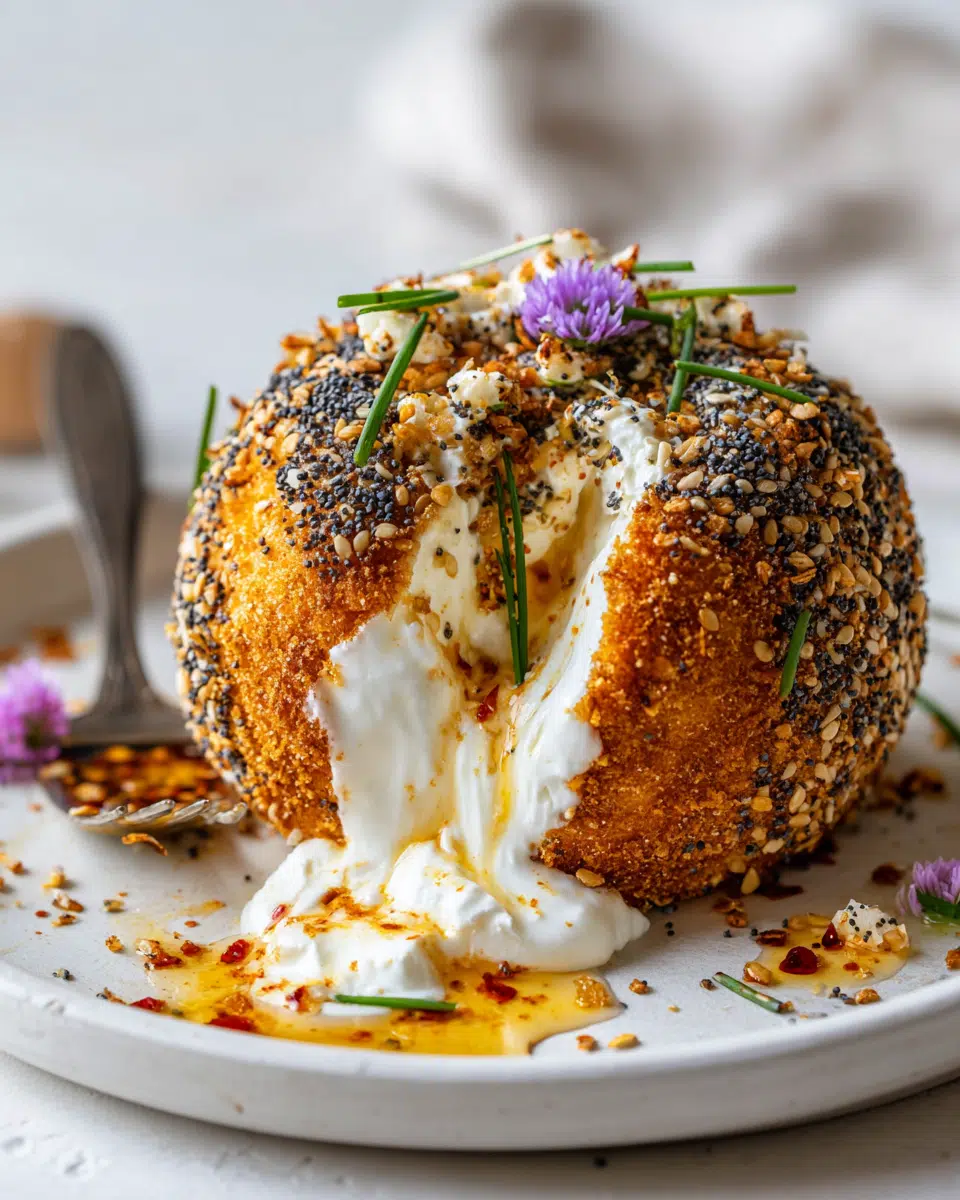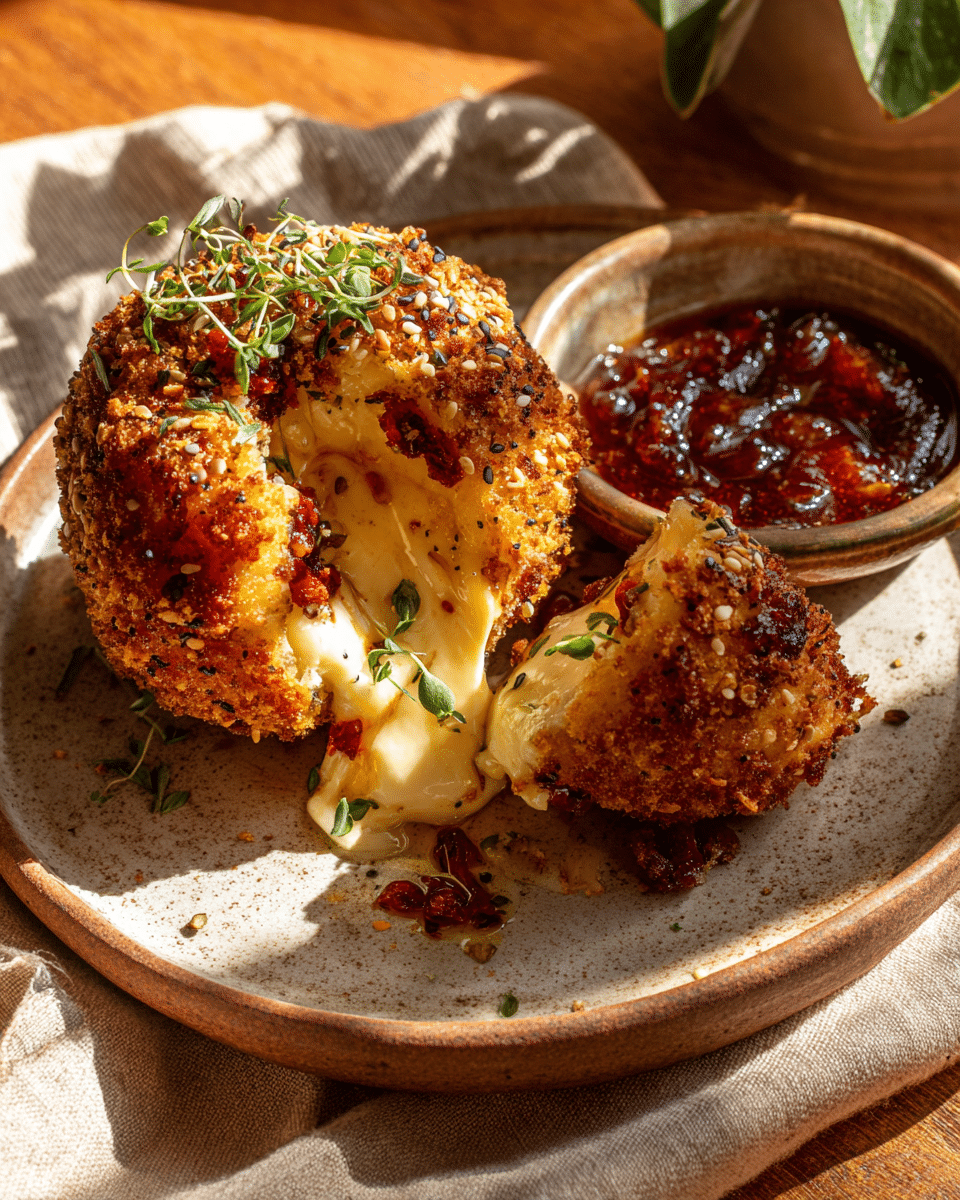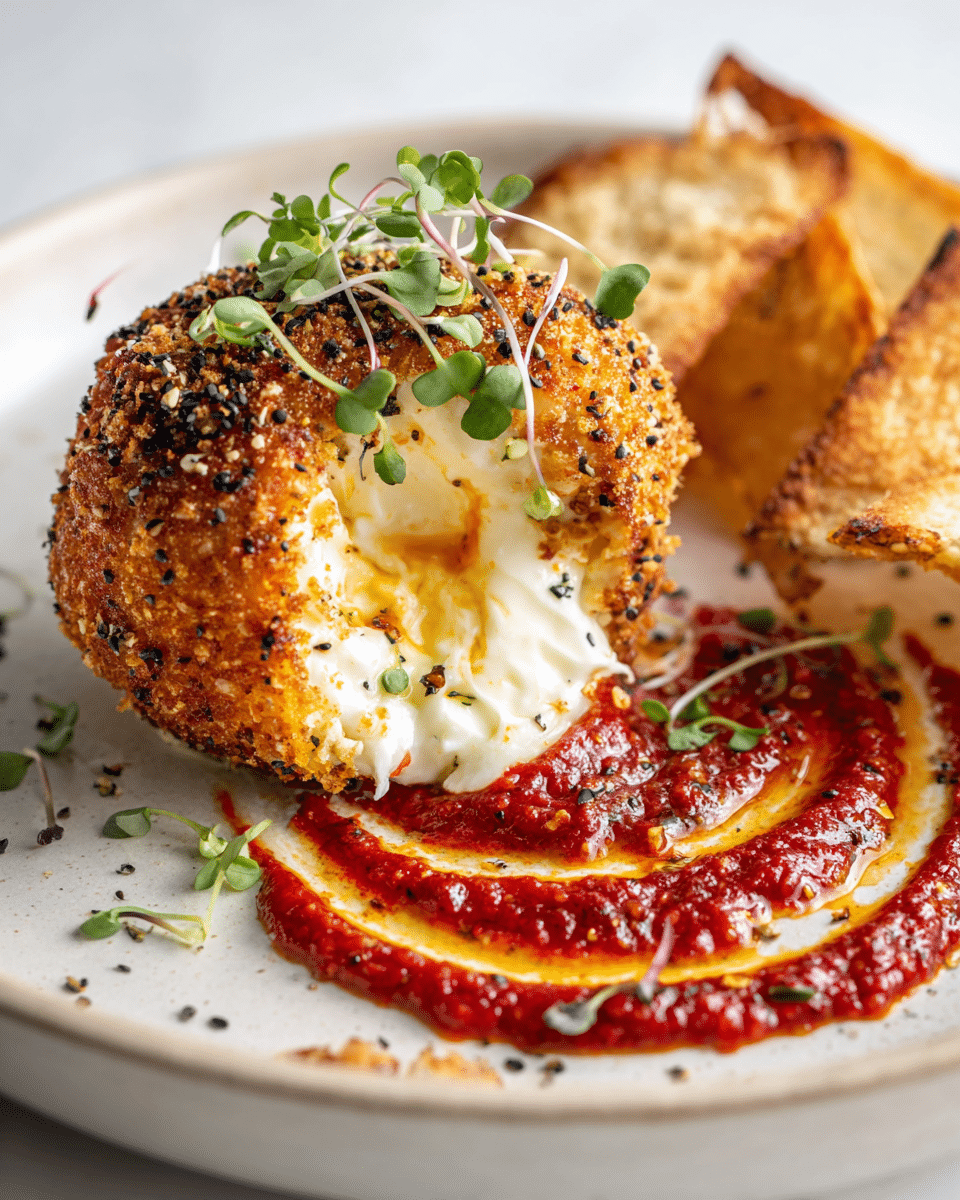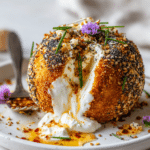

Table of Contents
Table of Contents
Creamy, rich, and indulgently soft, burrata is no ordinary cheese—it’s a full-on flavor experience. But what happens when you take this decadent dairy, gently melt it, and wrap it in a crispy, golden bagel crust? You get the Molten Burrata Recipe that’s taking gourmet kitchens by storm. Whether you’re a cheese lover, an experimental foodie, or simply someone looking to impress guests at dinner, this recipe hits all the right notes.
In this article, we’ll uncover what makes burrata so magical, walk you through the luxurious molten burrata sphere technique, and answer common questions like “Are you supposed to melt burrata?” and “What exactly is in a burrata ball?” Along the way, we’ll highlight pro tips, mouthwatering pairings, and essential know-how to serve this dish perfectly every time.
Looking for inspiration? Try our Burrata with Roasted Plums to pair with burrata appetizers.
Inside a Burrata Ball: What’s Really In There?
What is a burrata ball made of?
At first glance, burrata may seem like a simple cheese ball—but it’s far more than that. The outside is a delicate pouch of fresh mozzarella, gently stretched and formed by hand. Inside, it’s filled with a luscious mixture called stracciatella, a creamy blend of fresh cream and shredded mozzarella curds. This dual texture is what gives burrata its iconic richness and soft, oozing center.
Here’s a quick breakdown:
| Component | Description |
|---|---|
| Outer Shell | Fresh mozzarella, formed into a soft, elastic pouch |
| Inner Filling | Stracciatella: mozzarella curds + heavy cream |
The result? A cheese that’s both structured and soft, making it ideal for slicing open tableside to reveal the creamy core. Burrata originated in the Apulia region of Italy, and since then, it has become a favorite worldwide—especially when featured in modern recipes like the molten burrata sphere.
How burrata is crafted: mozzarella shell and stracciatella filling
To craft burrata, cheesemakers first stretch mozzarella curds into a pliable outer skin while still warm. Once formed, this pouch is quickly filled with the stracciatella blend and sealed tight. Timing is crucial here—if the mozzarella cools down too much, it becomes brittle and unworkable. That’s why handmade burrata has such a luxurious quality—it’s always fresh and made with care.
Cheesemaking tips from top producers note that the cream used in the filling is what elevates the burrata’s flavor. High-fat, ultra-fresh cream gives it a smoother mouthfeel and keeps it soft even when cooled.
Check out Whipped Ricotta to learn more about traditional cheese crafting methods.
By understanding the components of a burrata ball, you’ll better appreciate the textures and flavors that come alive when it’s warmed and paired with a crisp crust—setting the stage for the molten burrata recipe that follows.
What Makes Burrata So Special in Every Bite
What’s so special about burrata?
There’s cheese—and then there’s burrata. What sets burrata apart is its contrast of textures and layers of richness that surprise your taste buds with every bite. Unlike standard mozzarella, burrata offers a combination of delicate firmness on the outside and creamy decadence on the inside. It’s soft, spreadable, and exceptionally flavorful, especially when served at room temperature or gently warmed in a molten burrata recipe.
Here’s why burrata stands out from the crowd:
- Dual Texture Experience: Firm outer shell + luscious inner cream
- Flavor Absorption: Its subtle taste pairs beautifully with both sweet and savory ingredients
- Freshness Matters: Burrata is best consumed within days of being made, ensuring peak creaminess
- Culinary Versatility: Ideal for salads, pastas, charcuterie, and gourmet creations like burrata spheres
When you cut into a burrata ball, the filling flows out like a river of cream and curds—turning any dish from ordinary to elegant. This makes burrata an all-time favorite among chefs, food influencers, and anyone who craves a melt-in-your-mouth moment.
Burrata vs. mozzarella: flavor, texture, and richness differences
While burrata and mozzarella both start from the same curds, they end up as totally different cheeses.
| Feature | Mozzarella | Burrata |
|---|---|---|
| Texture | Smooth, elastic, uniformly firm | Outer shell firm; inside soft & creamy |
| Flavor | Mild, slightly salty | Rich, buttery, slightly tangy |
| Culinary Use | Melts easily on pizza or lasagna | Best served fresh or gently warmed |
| Visual Appeal | Consistent ball or log shape | Often served whole, sliced open |
Mozzarella is excellent for melting evenly, but burrata is prized for its fresh, creamy finish that elevates dishes to fine-dining status. It’s no wonder chefs love pairing burrata with heirloom tomatoes, aged balsamic, fresh herbs, or wrapping it in a warm bagel crust for dramatic effect.
Molten burrata turns this cheese into a centerpiece—softened to perfection without losing its form and encased in a crunchy, golden crust.
Discover great ideas like our Rustic Peach Galette with Buttery Crust for perfect seasonal pairings


How to Enjoy a Burrata Ball the Right Way
How to eat a burrata ball
Burrata isn’t just a cheese—it’s a culinary event. When served properly, it should be the star of the table. The key is not overcomplicating it. Burrata is best when allowed to shine alongside simple, high-quality ingredients. Whether you’re slicing into it cold or presenting it as a molten burrata recipe, there’s a right way to savor it.
Here’s how to eat a burrata ball like a pro:
- Serve at Room Temperature: Remove from the fridge 30 minutes before serving. This enhances the creaminess.
- Place It Whole on the Plate: Keep it intact until it hits the table for dramatic presentation.
- Slice Gently: Use a sharp knife to make a clean cut—watch the stracciatella flow out.
- Scoop and Spread: Spoon the molten or creamy center onto toast, bagel chips, roasted vegetables, or even fruits.
- Drizzle & Sprinkle: Add extra virgin olive oil, flaky sea salt, and fresh cracked pepper. A dash of balsamic glaze can elevate the flavor even more.
Pro Tip: If you’re serving molten burrata, the inside should be just warm enough to ooze but not so hot that it becomes watery or rubbery.
Serving ideas: pairings with fruits, breads, and oils
Burrata is one of the most versatile cheeses to pair with various flavor profiles. Whether sweet or savory, it adapts beautifully and enhances the whole dish. Here are some classic and creative pairing ideas:
🥖 Bread & Grains
- Grilled sourdough
- Rosemary focaccia
- Seeded bagel crisps (great for the bagel crust variation)
- Warm pita wedges
🍅 Fruits & Vegetables
- Cherry tomatoes and basil (classic caprese-style)
- Roasted beets with orange zest
- Grilled peaches or figs
- Avocado slices and arugula
🍶 Drizzles & Dressings
- Extra virgin olive oil
- Balsamic reduction
- Hot honey (for a spicy-sweet twist)
- Lemon zest + chili flakes
🧂 Finishing Touches
- Cracked pink peppercorn
- Flaky sea salt
- Toasted pine nuts
- Microgreens or edible flowers for visual appeal
These combinations help accentuate burrata’s soft texture and creamy richness. When melted and wrapped in a bagel crust, the cheese becomes even more indulgent—like a creamy explosion surrounded by crispy perfection.
Molten Burrata Sphere with Bagel Crust: A Gourmet Twist
Ingredients and step-by-step preparation
Ready to turn heads at your next dinner party? This molten burrata recipe combines the gooey charm of burrata with the chewy crunch of a seasoned bagel crust. It’s indulgent, it’s comforting, and surprisingly easy to make with the right technique.
Here’s what you’ll need:
🧀 Ingredients:
| Item | Quantity |
|---|---|
| Fresh burrata balls | 2 (about 4 oz each) |
| Plain bagels | 2 (toasted and finely ground into crumbs) |
| All-purpose flour | 1 cup |
| Eggs (beaten) | 2 |
| Milk | 2 tbsp |
| Olive oil or butter | 1 tbsp (for added crust flavor) |
| Salt & pepper | To taste |
| Garlic powder (optional) | ½ tsp |
Optional Garnish: Fresh thyme, crushed red pepper, microgreens
Step-by-step: How to make the molten burrata sphere with bagel crust
- Prep the crust coating
Toast the bagels until golden and crunchy. Use a food processor to pulse into fine crumbs. Mix in garlic powder, pepper, and a touch of salt for extra flavor. - Chill your burrata slightly
Place burrata in the freezer for 15 minutes. This firms it up just enough to handle during the breading process without bursting. - Set up the dredging station
Prepare three bowls:
- Bowl 1: Flour
- Bowl 2: Beaten eggs mixed with milk
- Bowl 3: Bagel crumbs
- Coat your burrata
Gently roll the burrata in flour → dip in egg wash → coat fully in bagel crumbs. Repeat for an extra thick crust. - Freeze for 15-20 minutes
This helps the crust stick and keeps the burrata from melting too quickly during cooking. - Cook the sphere
You can either pan-fry or air-fry it:- Pan-Fry: Heat olive oil over medium heat, fry for 2-3 minutes per side until golden.
- Air-Fry: Spray with oil, cook at 375°F for 6-8 minutes.
- Check for melt
When you slice it open, the inside should be warm and creamy—not hot and runny. - Plate creatively
Serve over a smear of pesto, marinara, or roasted tomato purée. Top with microgreens, a drizzle of balsamic glaze, or a poached egg for richness.


Techniques for melting burrata properly without ruining texture
Burrata’s delicate structure means high heat is its enemy. The goal is to warm the inside enough to soften the cream without making the outer shell rubbery.
Here are some pro tips:
- Low and slow: Use medium heat and short cooking times
- Crust insulation: Bagel crumbs help regulate the heat around the cheese
- Avoid direct oven broiling: This can dry out the shell before the inside is ready
- Freezing hack: Chilling the ball before cooking helps keep the filling from leaking out too early
If you’re air frying, preheat your machine for even cooking and avoid flipping too often to prevent bursting.
Why bagel crust works perfectly for molten burrata
Using a bagel as the base for the crust isn’t just trendy—it’s genius. Here’s why:
- Texture balance: Bagel crumbs give a chewy crunch that contrasts the creaminess of burrata
- Flavor hold: The dense crumb absorbs seasonings and holds onto olive oil beautifully
- Golden finish: Bagel crust browns evenly and crisps up better than plain breadcrumbs
- Uniqueness: This twist elevates the dish into something memorable and gourmet
You can use everything bagels for an herby, garlicky version or cinnamon-raisin bagels if you’re pairing with fruit for a sweet-savory approach.
Expert Tips, Common Questions, and Recipe FAQ
Are you supposed to melt burrata?
Not exactly—but warming it gently is a game-changer. Traditional burrata is meant to be served fresh at room temperature. However, the molten burrata recipe adds an exciting culinary twist. The goal isn’t to melt it into goo, but rather to soften the interior so it becomes ultra creamy, while keeping the outer mozzarella intact. Done right, the result is a golden-crusted sphere that oozes luxurious cheese when sliced open.
Here’s how to melt burrata the right way:
- Flash frying or air frying with a crust helps insulate the burrata
- Avoid direct high heat or long oven bakes
- Freeze slightly before heating to preserve structure
- Use a coating (like bagel crumbs or panko) to protect the outer shell
Remember: Overheating can cause the cream to separate or the shell to burst.
Best ways to heat burrata gently
| Method | Time & Temp | Best For |
|---|---|---|
| Pan-Fry | Medium heat, 2–3 minutes per side | Crisp crusts, quick melt |
| Air Fryer | 375°F, 6–8 minutes | Healthier, even crisp |
| Indirect Oven Heat | 325°F for 10 minutes (wrapped) | Controlled softening |
You should never microwave burrata—it breaks the emulsion of the creamy filling and ruins the delicate flavor profile.
Storing, reheating, and plating for visual appeal
If you’re prepping burrata spheres ahead of time, you can refrigerate the coated, uncooked burrata balls in an airtight container for up to 24 hours. Before cooking, let them sit at room temperature for 10 minutes.
Reheating?
Reheat gently in an air fryer or low oven (275°F) for a few minutes. Avoid microwaves or high oven temps.
Plating Tips:
- Slice open at the table for a dramatic reveal
- Place on a painted swipe of basil pesto or beet hummus
- Garnish with edible flowers, microgreens, or cracked pink peppercorns
- Serve with toasted bagel chips or flatbread
FAQs About molten burrata
What is a burrata ball made of?
A burrata ball is made from a pouch of fresh mozzarella filled with a rich blend of shredded mozzarella curds and cream, known as stracciatella. The outer shell provides a soft bite, while the inside delivers a creamy, buttery texture.
What’s so special about molten burrata?
Its dual texture and rich flavor make burrata unique. It’s both fresh and decadent, versatile in sweet or savory dishes, and always impressive on a plate—especially when turned into a molten burrata sphere.
How to eat a burrata ball?
Slice it gently and spoon the creamy center onto bread, salads, or roasted veggies. Add olive oil, balsamic glaze, or honey for a flavor boost. Burrata is best served fresh, but molten variations like this recipe elevate its elegance.
Are you supposed to melt burrata?
Traditionally no, but in this molten burrata recipe, it’s warmed just enough to become creamy without falling apart. The trick is using a crust like bagel crumbs to protect it during cooking.
Want more recipes & inspo? Follow me on Facebook and save your favorites on Pinterest!
Print
Molten Burrata Recipe: A Creamy Explosion with Crunch You’ll Crave
- Total Time: 28 mins
- Yield: 2 servings
- Diet: Vegetarian
Description
Molten burrata wrapped in a golden bagel crust delivers a creamy explosion with a perfect crunch—an elegant appetizer for cheese lovers.
Ingredients
2 fresh burrata balls (about 4 oz each)
2 toasted plain bagels, finely ground into crumbs
1 cup all-purpose flour
2 eggs, beaten
2 tbsp milk
1 tbsp olive oil or butter
Salt and pepper to taste
½ tsp garlic powder (optional)
Instructions
1. Place burrata balls in the freezer for 15 minutes to firm them slightly.
2. Toast bagels, then pulse in a food processor to create fine crumbs. Season with garlic powder and pepper.
3. Set up three bowls for dredging: flour, egg wash (egg + milk), and bagel crumbs.
4. Roll each burrata in flour, dip in egg wash, and coat fully in the bagel crumbs. Repeat for extra crunch.
5. Freeze the coated burrata again for 15–20 minutes.
6. Pan-fry in olive oil over medium heat for 2–3 minutes per side until golden, or air-fry at 375°F for 6–8 minutes.
7. Slice gently to reveal the molten interior and serve immediately on a sauce base.
Notes
Chill burrata before coating to avoid leaks while cooking.
Use flavored bagels for variety—try everything or herb-seasoned styles.
Serve with pesto, tomato purée, or balsamic drizzle for extra flavor.
- Prep Time: 20 mins
- Cook Time: 8 mins
- Category: Appetizer
- Method: Pan-Fry / Air-Fry
- Cuisine: Italian-American
